R. James Cook
doi:10.1094/APSFeature-2008-08
The American Phytopathological Society (APS) is arguably among the most robust, service-oriented, and successful scientific societies in the world, whether measured by the quality and number of its journal and nonjournal publications, public service and outreach, leadership among its scientific-society peer group, success of its annual meetings, international leadership and service, member services, member volunteerism, or financial health. With now more than 5,000 members, it may well be the most successful of all professional scientific societies of similar size in the United States if not the world. It is my honor and privilege to be invited to tell the 100-year success story of APS, from its humble yet visionary beginnings through our centenary celebration.
The American Association for the Advancement of Science (AAAS), formed in 1848, is to be credited with fostering the development of plant pathology as a science in America and for providing the leadership that led to the formation of APS. A committee of AAAS members consisting of J. C. Arthur, C. E. Bessey, W. G. Farlow, T. J. Burrill, and C. H. Peck was appointed in 1884 for the "encouragement of research on the health and disease of plants." This AAAS committee wrote in 1885 to the Commissioner (now Secretary) of Agriculture urging that plant diseases be included as part of the studies of the Department’s botanist. In response, a Section of Mycology was established within the USDA Division of Botany, with F. Lamson-Scribner as the head, starting in 1885. In 1890, the Commissioner of Agriculture established the Division of Vegetable Pathology with Beverly Galloway as chief. The Journal of Mycology, devoted at first entirely to taxonomy of fungi by the Section of Mycology, was taken over by the Division of Vegetable Pathology as an outlet for information on plant diseases, and as such became the first American journal for plant pathology. It was also under the auspices of AAAS that USDA plant pathologist C. L. Shear organized a meeting, held on December 30, 1908, during the annual meeting of AAAS held that year in Baltimore, to discuss the formation of an independent American scientific society for plant pathologists.
| |
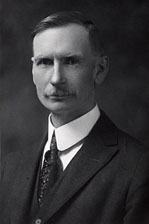 |
|
C. L. Shear, a USDA plant pathologist, organized the meeting on December 30, 1908, that led to the formation of The American Phytopathological Society one year later. He was the first secretary-treasurer of APS, served on the first editorial board of Phytopathology, and was elected president in 1919. The photo was taken while he was president. |
|
Fifty-four people attended the organizational meeting led by Shear. The statement released from that meeting read:
It is our opinion that an American Phytopathological Society placed upon a broad and generous foundation, may be of invaluable aid in promoting the future development of this important and rapidly growing subject in America, and that its influence may be made of international importance.
It is interesting to note the similarities between this humble yet visionary statement and the Society’s 2007 Vision Statement:
The APS will be a diverse global community of scientists that: provides credible and beneficial information related to plant health; advocates and participates in the exchange of knowledge with the public, policy makers, and the larger scientific community; and promotes and provides opportunities for scientific communication, career preparation and professional development for its members.
The first officers of APS were elected at that 1908 organizational meeting: President L. R. Jones, University of Wisconsin; Vice President A. D. Selby, Ohio Agricultural Experiment Station; Secretary-Treasurer C. L. Shear, USDA; and Councilors J. B. S. Norton, University of Maryland, and B. M. Duggar, Cornell University. The officers wrote a constitution and bylaws for the new organization, and 130 people responded to the invitation to join APS as charter members. Dues were set at 50 cents.
The first meeting of APS was held jointly with AAAS the following year, on December 30-31, 1909, in Boston; 50 members attended and 45 papers were presented. Dues were raised to $1. The new officers elected at that first official meeting were President F. L. Stevens, North Carolina State; Vice President A. F. Woods, University of Minnesota; Secretary-Treasurer C. L. Shear; and Councilors L. R. Jones, A. D. Selby, and H. H. Whetzel, Cornell University. APS was incorporated under the laws of the District of Columbia on October 25, 1915.
Leadership in the Promotion of Excellence in Plant Pathology
APS has promoted excellence in plant pathology largely through its high-quality publications, and therefore this first section is primarily a historical account of the steps forward (and sometimes backward) in the development and maintenance of journals first, then books, and now online publications. It is through these instruments and those of other professional plant pathology societies that plant pathologists from all over the world, not just in America, have built the science and practice of plant pathology that we know today.
Dr. Jim MacDonald in his symposium presentation on "Growth of APS as a Publisher of Plant Pathology Literature" at the APS Centennial Meeting illustrated the remarkable growth of APS publications in the last 30 years. This figure shows the exponential increase in titles published by APS.
| |
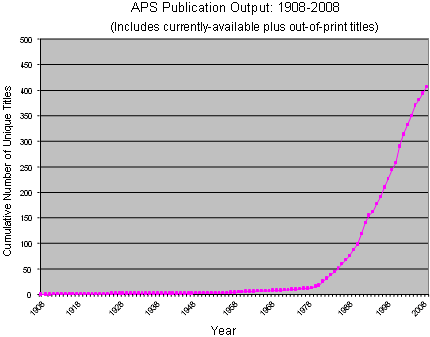
Cumulative number of titles (journals, books, compendia, Phytopathology Classics, etc.) published by APS over the past 100 years. |
|
The Society’s Flagship Publication: Phytopathology
It was also decided at that first meeting of APS to start a new journal, to be named Phytopathology. Launched as a bimonthly journal with Volume 1, Number 1, issued in February 1911, Phytopathology became a monthly publication with the January issue of Volume 8 in 1918. The first editorial board was chaired by L. R. Jones and supported by editors C. L. Shear and H. H. Whetzel, with 12 associate editors and Donald Reddick as business manager. The title of editor-in-chief was first used in 1921, and the subtitle, An International Journal, was added in 1925. A European editor was added in 1924, starting with H. M. Quanjer of Wageningen, but this arrangement was discontinued in 1943. The decision to charge for reprints was made at the 1950 annual meeting in Memphis.
| |
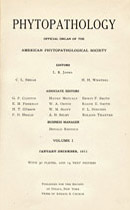
Cover of the first issue of Phytopathology, issued in February 1911 as a bimonthly journal. Phytopathology became a monthly publication with the January issue. |
Growth of Phytopathology in scientific stature and popularity during its early years soon led to the day when the onerous and even burdensome duties of editor-in-chief were making it difficult to attract a member to serve voluntarily in this role. After 11 members reportedly turned down the request to serve as editor-in-chief in the late 1950s, immediate past president Helen Hart captured the dilemma in a letter dated July 2, 1957, to President George Fischer: "I feel quite certain that practically everyone … at the present time is loathe to give up his opportunities for research and teaching in order to assume the editorial work." A. F. Ross, then editor-in-chief, had suggested that a grant-in-aid or honorarium might help, but Hart foresaw the day when "we are going to have to employ more paid workers on some of our routine society business." Saul Rich, treasurer and business manager, objected to Ross’s suggestion, stating that "to offer money as a lure may attract the wrong kind of person to the job."
Rich proposed that the Society "pattern the editorial management of Phytopathology after that of the Proceedings of the National Academy of Sciences," whereby authors would obtain "original letters from three members who would state that the manuscript has met certain standards set by the editor-in-chief, and who would then accept the manuscript on behalf of the Society. The author would then send the approved manuscript to the printer together with the accepting letters." Rich claimed to know of two members willing to serve on these terms. In a blunt response, Ross wrote on July 8, 1957, that "the proposal as outlined [by Rich] would ruin the journal" and that "it would result in a marked lowering of the quality of our publication." Ross pointed out that "the author would be free to choose reviewers whom he knew in advance would approve the paper as written," and if "one or more of these reviewers did not approve the paper, he would be free to choose other reviewers … until he obtained three signatures." Ross added that "a dedicated man would … tolerate drudgery and carping criticism in order to do a job as he thinks it should be done; he might or might not need money."
Plant Disease — The Long-Desired Second Journal
Discussions of the need for a second journal go back at least 50 years, motivated in large part by complaints from members doing applied research that Phytopathology was not meeting their needs. My own files from my service on a Special Projects Committee appointed by President Arthur Kelman in 1967 with the charge "to take a broad view of existing projects and sharpen focus on areas in need of further project strength" show that a second journal for applied research was one of the committee’s key recommendations. President James Tammen in 1975 appointed a committee to study the feasibility of publishing a second journal. While there seems to be no record of a report from this committee in the APS Proceedings, their service coincidentally would be preempted that same year by the announcement from USDA-ARS that Plant Disease Reporter (PDR), started in 1917, would be discontinued as part of a budget cut. The initial response of Council under President Durward Bateman to the USDA announcement was to save PDR as an ARS publication. This response quickly gave way to the idea that APS might take on PDR as the long-desired second journal of the Society for publication of applied research. As Tarleton recalls it, "When Ed [Kendrick, then high in USDA administration] alerted the APS officers that the department was really serious about dropping Plant Disease Reporter, discussions were held by APS officers to determine if we could or should take it over. Most opinions expressed the need for this type of information and APS should try and assume the publishing role. The key element was money and Ed Kendrick was in a position to do something about this. Ed organized a grant [from USDA-ARS] to provide APS with starting money. Also, staff was asked if physically we could edit and publish another monthly journal—the answer was yes if we could beef up our editorial staff. This was accomplished along with a major design change orchestrated by an APS committee and staff." That grant turned out to be $236,000 provided in two installments.
President Jack Schafer appointed a committee in November 1978 at the annual meeting in Tucson, with me as the chair, and charged us to design or redesign and launch this new, yet ongoing journal. Three new sections—an editorial page, Features, and a Focus page on the latest in plant pathology published in other journals—were added in addition to the research articles. The name was changed to Plant Disease as the appropriate applied counterpart to Phytopathology, but the PDR volume numbers were continued, starting with Volume 64 in January 1980. In fact, and a testimony to the outstanding professional staff led by Tarleton, the first issue dated January 1980 was actually published in July 1979, only seven months after the decision by Council to assume publication of this journal. This allowed the Society six months to market a journal that would no longer be free. Twenty thousand copies of the premier issue were mailed in July 1979 to members, libraries, and other potential subscribers to promote the revamped publication. At the 1979 annual meeting, Plant Disease was approved by the APS members as an official journal of the Society, with Malcolm Shurtleff as the first editor-in-chief.
| |
Cover of the first issue of Plant Disease, formerly Plant Disease Reporter (PDR) published by the U.S. Department of Agriculture starting starting with Volume 1 in 1917 through Volume 63 in 1979, and then as an official monthly journal of the American Phytopathological Society starting with Volume 64 in 1980. This January 1980 issue of Plant Disease was actually published in July 1979 and mailed to some 20,000 potential subscribers as part of a promotion of this journal that would no longer be free. |
|
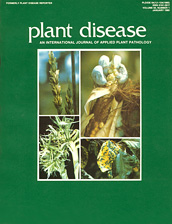 |
|
Molecular Plant-Microbe Interactions
The next (third) major journal taken on by the Society was Molecular Plant-Microbe Interactions (MPMI). MPMI was launched in 1987 as a new journal shared with the International Society for Molecular Plant-Microbe Interactions (IS-MPMI) and was sponsored initially by APS PRESS. George Bruening was appointed as the first editorin- chief. Two years later, at the annual meeting in Richmond, Council approved offering MPMI as a journal option for members, appointed Luis Sequeira to succeed Bruening as editor-in-chief, and added the MPMI editor-in-chief as a member of Council. Sequeira as president of APS in 1986 had appointed an ad hoc committee to review the need and opportunity for a new journal. He was also a member of IS-MPMI and took the lead in obtaining the agreement that MPMI would serve as an official journal of both IS-MPMI and APS.
As a relatively new scientific society, IS-MPMI had few resources to start a journal. APS, with its publication infrastructure and healthy financial status, thus underwrote essentially all of the start-up costs for MPMI, including the design, production, promotion, marketing, and distribution. This was a strategic investment on the forefront of molecular plant pathology as an emerging field of science, and it addressed the need for APS to provide young scientists with another reason to join the Society. Sharing this journal also headed off the possibility that ISMPMI might find another way to start a competing journal. However, while editorial and financial responsibilities for MPMI were transferred to and assumed by a joint committee of APS and IS-MPMI in 1990, it was not until 1992 that an agreement on sharing of revenue was reached, when the IS-MPMI Executive Committee accepted an offer of royalty payments from APS based on the number of personal and library subscriptions to the journal.
| |
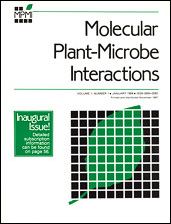 |
|
Cover of the first issue of Molecular Plant-Microbe Interactions (MPMI), launched in 1987 as a new journal of the American Phytopathological Society shared with the International Society for Molecular Plant-Microbe Interactions. MPMI was sponsored initially by APS PRESS and then became a journal option for members of APS in 1989. |
|
Early Nonjournal Publications
The Society stepped early but also modestly into the business of publishing nonjournal materials with Phytopathological Classics, starting in 1926. Fungicide and Nematicide Tests (F & N) debuted in 1944 as a supplement to Plant Disease Reporter. The USDA had to discontinue this service due to budget cuts and APS picked it up as a Society publication starting in 1957. Phytopathology News began as a short newsletter issued to each member starting in 1948 and then became part of the advertising page of each issue of Phytopathology starting in 1951. Phytopathology News as a separate, monthly publication began in February 1967, with Malcolm Shurtleff as the first editor.
Formation of APS PRESS
One of my first formal actions as APS president following the 1983 meeting in Ames— in fact, even before the end of the meeting—was to appoint an ad hoc committee chaired by A. R. Weinhold to review the APS committee structure for nonjournal publications and recommend a more simplified structure that would also provide quality control. The need to take a fresh look at the APS infrastructure for nonjournal publications came up in a conversation I had with Ray Tarleton and Steve Nelson during our car ride from St. Paul to Ames to the 75th anniversary meeting of the Society. APS had evolved a complex structure of committees to guide it in selecting and publishing its growing number and variety of publications, including the Phytopathological Classics Committee, Phytopathological Monographs and Reviews Committee, Disease Compendium Committee, Books Committee, and Publications Coordinating Committee. Yet the manuscript Baker and I had submitted for our second book was never actually reviewed by any member of the Books Committee (although we had obtained our own external reviews before submitting the manuscript).
At the 1984 annual meeting on the campus of the University of Guelph in Ontario, Council approved the establishment of APS PRESS, with George Agrios as the first editor-in-chief. APS PRESS, with an editor-in-chief and associate editors, thus assumed a role equivalent to that of the editorial boards of Phytopathology and Plant Disease, including a position on Council for the editor-in-chief. All other committees were either discontinued, and their duties assumed by APS PRESS, or reorganized to be under the auspices of APS PRESS. Two years later, the Committee on Illustrations of Plant Pathogens and Diseases was similarly moved to become a committee under APS PRESS, with continuing responsibility for the production of marketable sets of slides and other illustrations.
The expansion of the Society’s in-house publication capability as APS PRESS was justified primarily as a service to members, both in publishing books authored by members and in providing books to members at a time when commercial scientific publishing houses had all but abandoned the individual book buyer by targeting library sales through extremely high pricing strategies. APS PRESS provided books at reasonable prices, often because the member-authors declined to accept royalties. Including compendia and four titles in the Plant Health Management series launched in 1991 with the publication of Wheat Health Management, more than 200 titles are available from APS PRESS as of this writing, generating income for fiscal year 2007 of $854,064, representing 18% of the annual income of the Society. Other productions include a large collection of slide sets and other teaching materials, and a CD-ROM collection that includes the proceedings of APS meetings starting with 2003. Because of the growth in the number of titles and the need to improve service to customers worldwide, APS PRESS opened an office in Europe in 1996.
Electronic and Online Publications
By the early 1990s, it was clear that to remain competitive as a publishing house, APS would need to make a successful transition from providing exclusively hard-copy journals and books sent through the mail and stored on shelves to embrace entirely electronic methods of journal and book production, dissemination, and storage. With nearly 80% of Society income dependent on the sale of books and journal subscriptions, the financial implications of this transition had to be faced and managed realistically. APS staff under the leadership of Ray Tarleton had, during the 1980s, made sure that APS publication practices took advantage of the savings and efficiencies offered by the latest technologies in word processing and desktop publishing by continually updating the in-house computers and software. This strategy of APS as an "early adopter" of electronic publishing, the skills of a dedicated APS staff, and the leadership and hard work of a few visionary members of the Society have been key to the success of APS in its transition to online publications and communications.
In 1992, Council appointed an ad hoc committee, called the Electronic Technology Committee, chaired by Larry Moore at Oregon State University "to aid staff in identifying the best technology for use at headquarters." This led, in 1994, to the launch of the highly successful APSnet which was introduced to the membership at the 86th annual meeting in Albuquerque. One outgrowth of this effort was a decision to convert to all-electronic handling of Plant Disease Notes. In 1993, J.D. MacDonald was appointed the first assigning editor of the Notes and charged with developing the procedures for e-mail-based submission, review, editing and final acceptance … a mission that was a challenge when e-mail was still in its infancy. As the number of electronic initiatives grew, President Sue Tolin, in 1995, repositioned the ad hoc committee, forming instead a standing committee of the society, called the Electronic Technology Advisory Committee (ETAC) and chaired by MacDonald. The ETAC was charged to "advise Council, journal editors and APS staff of opportunities to better serve members through electronic communications/publications." Again, in 1997, as the number of initiatives and policy complexities continued to expand, Council approved a further reorganization that created the Office of Electronic Communications (OEC) with MacDonald as the first director, and ETAC became a committee under OEC.
The first online electronic symposium held on APSnet was in 1996 on Karnal bunt; it began on June 24 and continued for several weeks after the 1996 annual meeting in Indianapolis. The following year, APS PRESS made its online debut with "Lessons in Plant Pathology" and the first online slide set, "Diseases, Pests, and Non-nutrient Disorders of Sugar Cane." Also in 1998, Gail Schumann and Jim MacDonald were awarded the Media Award of Excellence from the National Association of Colleges and Teachers of Agriculture for their 1996 effort to convert the Compendium of Turfgrass Diseases into a CD-Rom product under the auspices of APS PRESS. By the end of the 1990s, other professional agricultural scientific societies were looking to APS for leadership in online publishing.
Introduction of Online Journals
APS launched two online peer-reviewed publications in 2000: Plant Health Progress (PHP), with Tim Murray as its first editor-in-chief, and The Plant Health Instructor (PHI), focusing on instructional materials and scholarship in teaching, with Editor-in- Chief Gail Schumann. PHP also then became the founding publication for the online Plant Management Network (PMN), developed in partnership with the American Society of Agronomy and the Crop Science Society of America, and in cooperation with the Entomological Society of America, the Society of Nematologists, the Weed Science Society of America, and other related societies. This is another example of APS working with its peer group of professional scientific societies.
As noted above, F & N (Fungicide and Nematicide Tests) was assumed as an annual publication of the Society starting in 1957. In 1985, APS launched B & C (Biological and Cultural Tests) for reports relating to nonchemical methods of plant disease management, including biological control products, resistant varieties, and cultural practices; the first volume appeared in early 1986, and John Hartman was the first editor. Starting in 2002, both F & N and B & C were added as online publications of the newly formed PMN, and archives of the 2000–2006 volumes of F & N and 2001–2006 volumes of B & C are now accessible online through PMN. In 2007, F & N and B & C were merged into the single Plant Disease Management Reports (PDMR), with D. S. Egel as editor-in-chief. PDMR is now online through PMN.
Publications infrastructure and services have continued to be a priority with APS. For example, a new web page, APSnet III, went online during the summer of 2000; the APSnet Education Center, aimed at elementary and high school teachers, also launched in 2000; APS News Capsules started in 1997; and Web-based journal submissions and manuscript tracking became possible in 2004. After declining an invitation from Science in 2002 to participate in a PubMed Central program that provides free access to publications starting 6 months after publication, APS joined the program as of April 2005, making all of its journals available free online through PubMed Central but with a two-year delay. Starting in 2005, APS contracted with the University of Wisconsin to scan all back issues of Phytopathology, Plant Disease, and MPMI and to make them freely available on the worldwide web.
APS Publication Board
As of this 100-year celebration, the APS Publications Board consists of a chair; the editors-in-chief of Phytopathology, Plant Disease, MPMI, APS PRESS, Phytopathology News, Plant Health Progress, Plant Health Instructor and APSnet Education Center, and Plant Disease Management Reports; and the director of the Office of Electronic Communications.
